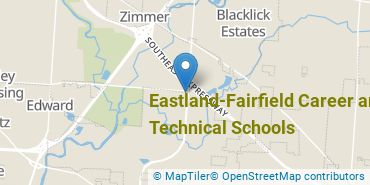Eastland-Fairfield Career and Technical Schools Healthcare Programs
Eastland-Fairfield Career and Technical Schools is a public institution situated in Groveport, Ohio. Groveport is a good match for students who enjoy the safety and convenience of the suburbs.
Featured schools near , edit
Where Is Eastland-Fairfield Career and Technical Schools?

Contact details for Eastland-Fairfield are given below.
| Contact Details | |
|---|---|
| Address: | 4300 Amalgamated Place, Groveport, OH 43125-9236 |
| Phone: | 614-836-4541 |
| Website: | www.eastlandfairfield.com |
Can I Afford Eastland-Fairfield Career and Technical Schools?
Student Loan Debt
While almost two-thirds of students nationwide take out loans to pay for college, the percentage may be quite different for the school you plan on attending. At Eastland-Fairfield, approximately 60% of students took out student loans averaging $4,730 a year. That adds up to $18,920 over four years for those students.
Eastland-Fairfield Career and Technical Schools Undergraduate Student Diversity
Gender Diversity
Of the 113 full-time undergraduates at Eastland-Fairfield, 78% are male and 22% are female.

Racial-Ethnic Diversity
The racial-ethnic breakdown of Eastland-Fairfield Career and Technical Schools students is as follows.

| Race/Ethnicity | Number of Grads |
|---|---|
| Asian | 1 |
| Black or African American | 29 |
| Hispanic or Latino | 2 |
| White | 77 |
| International Students | 0 |
| Other Races/Ethnicities | 4 |
Eastland-Fairfield Career and Technical Schools Healthcare Concentrations
The table below shows the number of awards for each concentration.
| Major | Undergraduate Certificate | TOTAL |
|---|---|---|
| Medical/Clinical Assistant | 1 | 1 |
| Dental Assisting/Assistant | 1 | 1 |
| Licensed Practical/Vocational Nurse Training | 0 | 0 |
| TOTAL | 2 | 2 |
References
*The racial-ethnic minorities count is calculated by taking the total number of students and subtracting white students, international students, and students whose race/ethnicity was unknown. This number is then divided by the total number of students at the school to obtain the racial-ethnic minorities percentage.
More about our data sources and methodologies.
